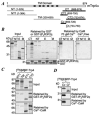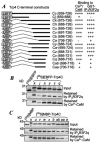Identification of common binding sites for calmodulin and inositol 1,4,5-trisphosphate receptors on the carboxyl termini of trp channels
- PMID: 11290752
- PMCID: PMC1847329
- DOI: 10.1074/jbc.M102316200
Identification of common binding sites for calmodulin and inositol 1,4,5-trisphosphate receptors on the carboxyl termini of trp channels
Abstract
Homologues of Drosophila Trp (transient receptor potential) form plasma membrane channels that mediate Ca(2+) entry following the activation of phospholipase C by cell surface receptors. Among the seven Trp homologous found in mammals, Trp3 has been shown to interact with and respond to IP(3) receptors (IP(3)Rs) for activation. Here we show that Trp4 and other Trp proteins also interact with IP(3)Rs. The IP(3)R-binding domain also interacts with calmodulin (CaM) in a Ca(2+)-dependent manner with affinities ranging from 10 nm for Trp2 to 290 nm for Trp6. In addition, other binding sites for CaM and IP(3)Rs are present in the alpha but not the beta isoform of Trp4. In the presence of Ca(2+), the Trp-IP(3)R interaction is inhibited by CaM. However, a synthetic peptide representing a Trp-binding domain of IP(3)Rs inhibited the binding of CaM to Trp3, -6, and -7 more effectively than that to Trp1, -2, -4, and -5. In inside-out membrane patches, Trp4 is activated strongly by calmidazolium, an antagonist of CaM, and a high (50 microm) but not a low (5 microm) concentration of the Trp-binding peptide of the IP(3)R. Our data support the view that both CaM and IP(3)Rs play important roles in controlling the gating of Trp-based channels. However, the sensitivity and responses to CaM and IP(3)Rs differ for each Trp.
Figures







Similar articles
-
Activation of Trp3 by inositol 1,4,5-trisphosphate receptors through displacement of inhibitory calmodulin from a common binding domain.Proc Natl Acad Sci U S A. 2001 Mar 13;98(6):3168-73. doi: 10.1073/pnas.051632698. Epub 2001 Feb 27. Proc Natl Acad Sci U S A. 2001. PMID: 11248050 Free PMC article.
-
The interaction of calmodulin with alternatively spliced isoforms of the type-I inositol trisphosphate receptor.J Biol Chem. 2000 Jan 28;275(4):2305-11. doi: 10.1074/jbc.275.4.2305. J Biol Chem. 2000. PMID: 10644679
-
The transient receptor potential, TRP4, cation channel is a novel member of the family of calmodulin binding proteins.Biochem J. 2001 May 1;355(Pt 3):663-70. doi: 10.1042/bj3550663. Biochem J. 2001. PMID: 11311128 Free PMC article.
-
Multiple roles of calmodulin and other Ca(2+)-binding proteins in the functional regulation of TRP channels.Pflugers Arch. 2005 Oct;451(1):105-15. doi: 10.1007/s00424-005-1427-1. Epub 2005 May 28. Pflugers Arch. 2005. PMID: 15924238 Review.
-
IP3 receptors and their regulation by calmodulin and cytosolic Ca2+.Cell Calcium. 2002 Nov-Dec;32(5-6):321-34. doi: 10.1016/s0143416002001859. Cell Calcium. 2002. PMID: 12543092 Review.
Cited by
-
Transient Receptor Potential Canonical (TRPC) Channels: Then and Now.Cells. 2020 Aug 28;9(9):1983. doi: 10.3390/cells9091983. Cells. 2020. PMID: 32872338 Free PMC article. Review.
-
Selective Gαi subunits as novel direct activators of transient receptor potential canonical (TRPC)4 and TRPC5 channels.J Biol Chem. 2012 May 18;287(21):17029-17039. doi: 10.1074/jbc.M111.326553. Epub 2012 Mar 28. J Biol Chem. 2012. PMID: 22457348 Free PMC article.
-
Ca2+-calmodulin-dependent myosin light chain kinase is essential for activation of TRPC5 channels expressed in HEK293 cells.J Physiol. 2006 Jan 15;570(Pt 2):219-35. doi: 10.1113/jphysiol.2005.097998. Epub 2005 Nov 10. J Physiol. 2006. PMID: 16284075 Free PMC article.
-
Structure-function analyses of the ion channel TRPC3 reveal that its cytoplasmic domain allosterically modulates channel gating.J Biol Chem. 2018 Oct 12;293(41):16102-16114. doi: 10.1074/jbc.RA118.005066. Epub 2018 Aug 23. J Biol Chem. 2018. PMID: 30139744 Free PMC article.
-
Agonist-activated Ca2+ influx occurs at stable plasma membrane and endoplasmic reticulum junctions.J Cell Sci. 2010 Dec 1;123(Pt 23):4170-81. doi: 10.1242/jcs.068387. Epub 2010 Nov 9. J Cell Sci. 2010. PMID: 21062895 Free PMC article.
References
Publication types
MeSH terms
Substances
Grants and funding
LinkOut - more resources
Full Text Sources
Other Literature Sources
Molecular Biology Databases
Miscellaneous

